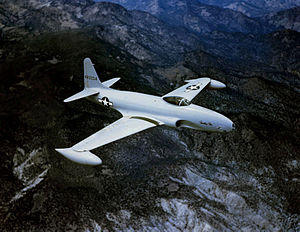RF-80 Shooting Star
| P-80 / F-80 Shooting Star | |
|---|---|
 |
|
| P-80A 44-85004 | |
| Role | Jet fighter |
| National origin | United States |
| Manufacturer | Lockheed Corporation |
| Designer | Clarence "Kelly" Johnson |
| First flight | 8 January 1944 |
| Introduction | 1945 |
| Status | Retired |
| Primary users |
United States Air Force United States Navy |
| Number built | 1,715 |
| Unit cost |
US$110,000 in 1945
|
| Variants | Lockheed T-33 Shooting Star |
| Developed into | Lockheed F-94 Starfire |
The Lockheed P-80 Shooting Star was the first jet fighter used operationally by the United States Army Air Forces (USAAF). Designed and built by Lockheed in 1943 and delivered just 143 days from the start of the design process, production models were flying, and two pre-production models did see very limited service in Italy just before the end of World War II. Designed with straight wings, the type saw extensive combat in Korea with the United States Air Force (USAF) as the F-80. America's first successful turbojet-powered combat aircraft, it helped usher in the "jet age" in the USAF, but was outclassed with the appearance of the swept-wing transonic MiG-15 and was quickly replaced in the air superiority role by the transonic F-86 Sabre. The F-94 Starfire, an all-weather interceptor on the same airframe, also saw Korean war service. The closely related T-33 Shooting Star trainer would remain in service with the U.S. Air Force and Navy well into the 1980s, with the last NT-33 variant not retired until April 1997. Many still serve in a military role in foreign air arms or are in private hands.
The XP-80 had a conventional all-metal airframe, with a slim low wing and tricycle landing gear. Like most early jets designed during World War II—and before the Allies captured German research data that showed the speed advantages of swept-wings—the XP-80 had straight wings, similar to previous propeller-driven fighters. It was the first operational jet fighter to have its engine in the fuselage, a format previously used in the pioneering German Heinkel He 178 V1 of 1939, and the slightly later British Gloster E.28/39 demonstrator of 1941. Other early jets generally had two engines because of their limited power, these being mounted in external nacelles for easier maintenance. With the advent of more powerful British jet engines, fuselage mounting was more effective, and it was used by nearly all subsequent fighter aircraft.
...
Wikipedia
